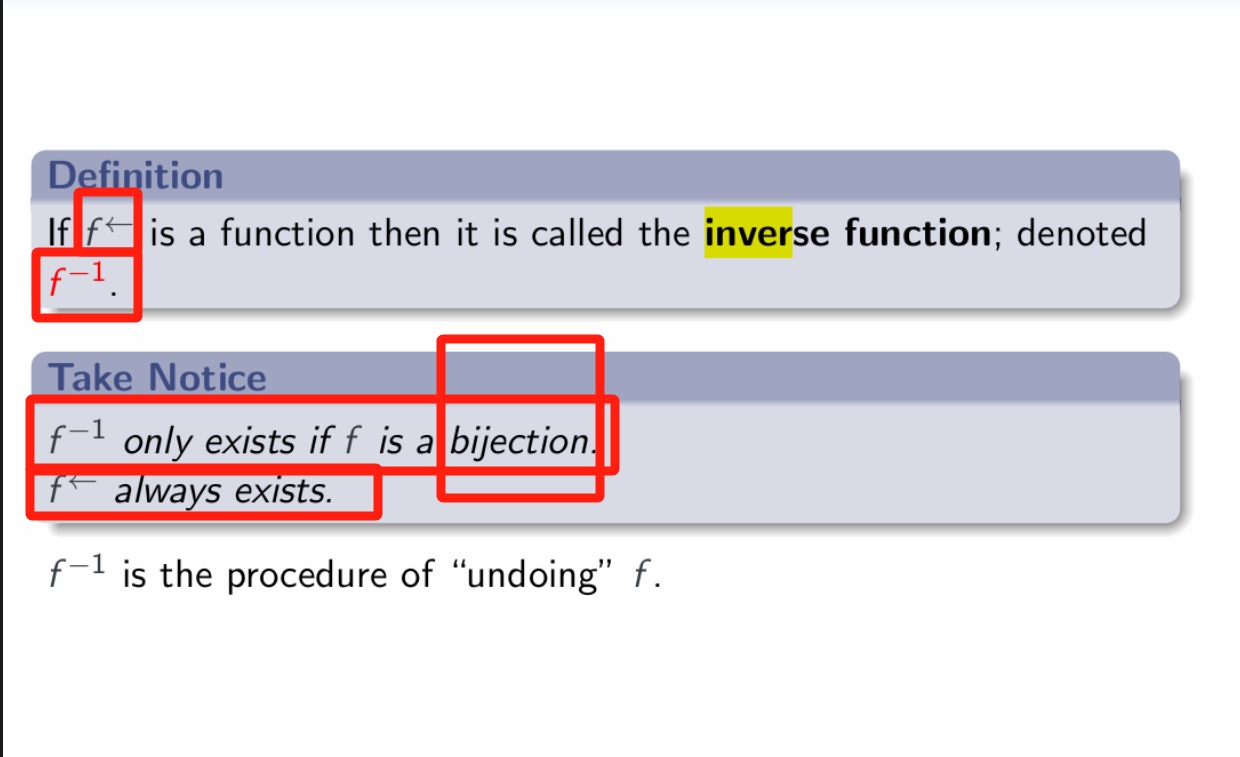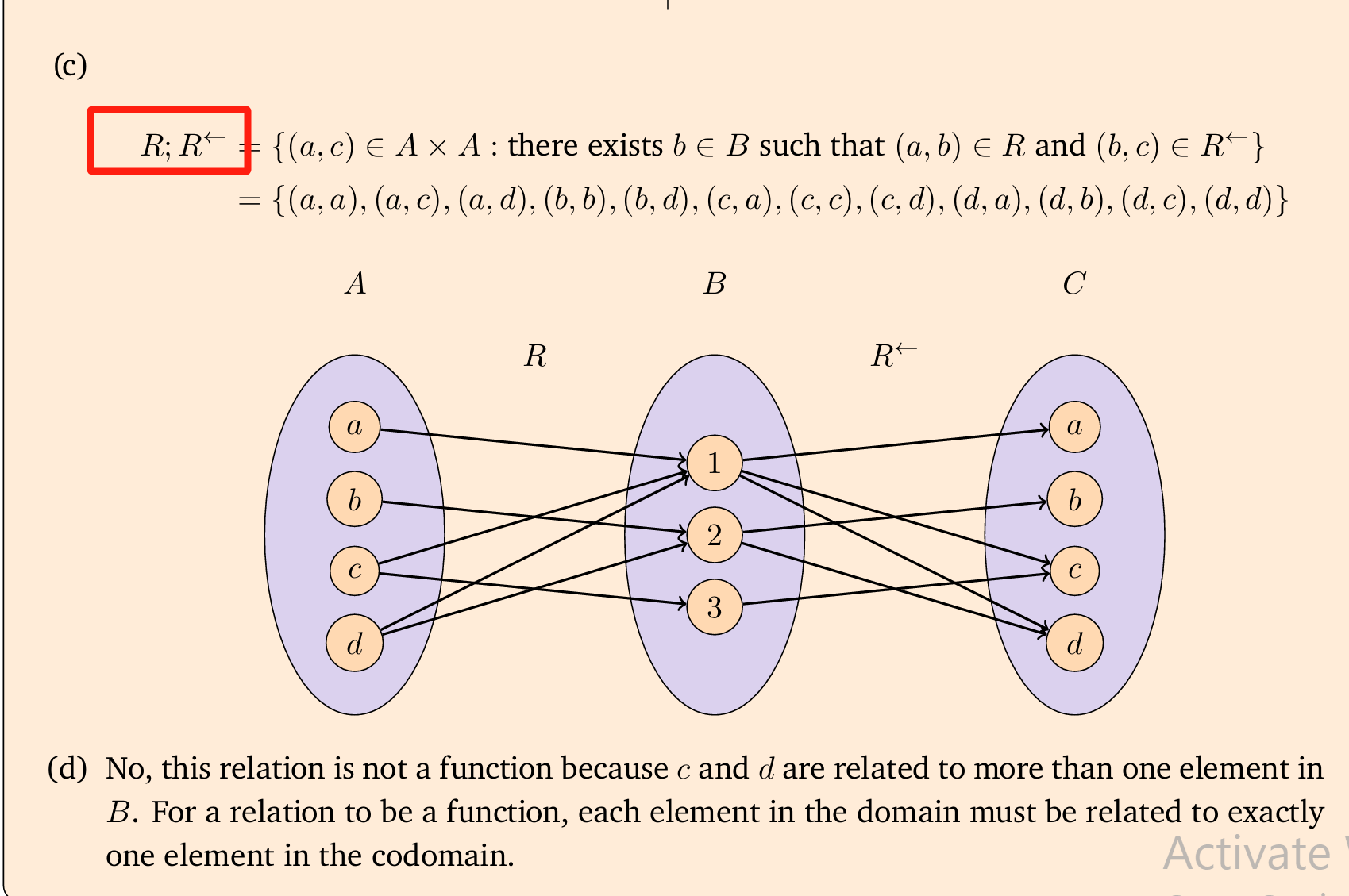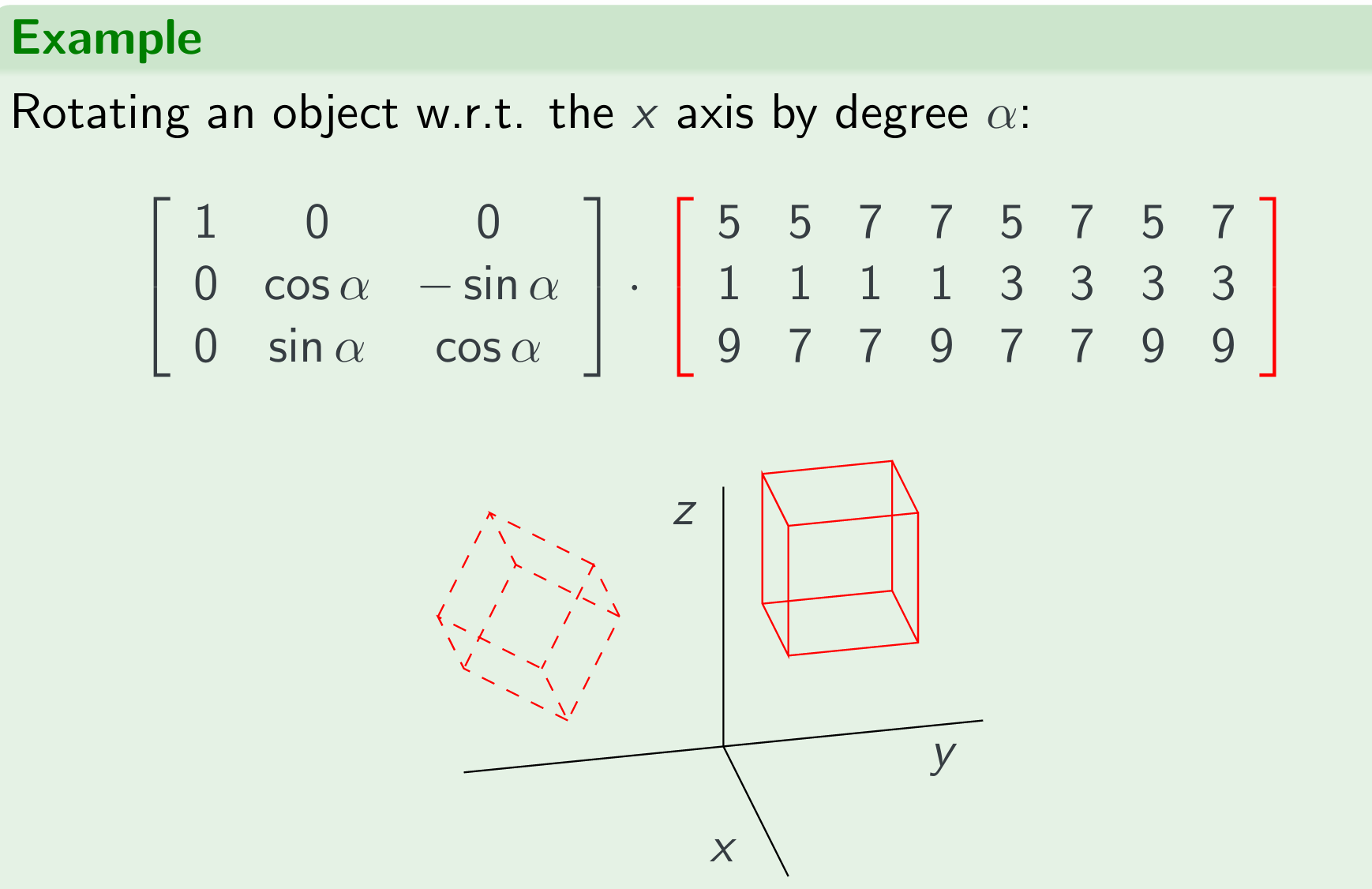- Functions Recap
- Functional Composition
- Inverse Functions
- Matrices
- \end{bmatrix}
- Introduction to Big-O Notation
Functions Recap
five properties fun-tot-inj-sur-bij
binary relation’s five properties: fun-tot-inj-sur-bij
Definition of function
A function, f : S → T, is a binary relation f ⊆ S ×T that satisfies (Fun) and (Tot). That is, for all s ∈ S there is exactly one t ∈ T such that (s,t) ∈ f.
We write f(s) for the unique element related to s.
We write $T^S$ for the set of all functions from S to T.
f : S →T describes pairing of the sets: it means that f assigns to every element s ∈ S a unique element t ∈ T. To emphasise where a specific element is sent, we can write f : x → y, which means the same as f(x) = y
| Symbol | Symbol | Symbol | Description |
|---|---|---|---|
| S | domain of f | Dom(f) | (inputs) |
| T | co-domain of f | Codom(f) | (possible outputs) |
| f(S) | image of f | Im(f) | (actual outputs) |
| S | domain of f | Dom(f) | (inputs) |
example
The identity function on S
Important!
The domain and co-domain are critical aspects of a function’s definition.
$f: \mathbb{N} \rightarrow \mathbb{Z}$ given by $f(x)=x^2$
and
$g: \mathbb{N} \rightarrow \mathbb{N}$ given by $g(x)=x^2$
are different functions even though they have the same behaviour!
Injective functions
Function $f : S → T$ is called an injection or 1-1 (one-to-one) if it satisfies (Inj)
Examples
functions that are injective
$f : N→N$ with $f(x) → x$
set complement (for a fixed universe)
functions that are not injective
absolute value, floor, ceiling
length of a word
Surjective functions
Function $f : S → T$ is called a surjection or onto if it satisfies (Sur). That is, if
Examples
functions that are surjective
$f : \mathbb{N} → \mathbb{N} \quad with \quad f(x) → x$
Floor, ceiling
functions that are not surjective
$f : \mathbb{N} → \mathbb{N} \quad with \quad f(x) → x^2$
Bijection functions
Both (Inj) and (Suj) functions
Functions on finite sets
Take Notice
For a finite set S and $f : S → S$ the properties surjective and injective are equivalent.
Functional Composition
Q: If $f : S →T$ and $g :T →U$ are functions, then $f;g$ is a relation. When is it a function?
A: In the lecture, I said Injective. But Jiaojiao smiled and questioned ‘Is it sufficient?’. The correct answer is ‘Bijective’.
Definition
If $f : S →T$ and $g :T →U$ then the composition of f and g, written $g◦f$ , is the function given by
That is, g ◦ f = f;g.
Take note of the order between f and g. f;g means f first and then g, and g ◦ f is the same of g(f(x)).
Facts
Composition is associative
h ◦(g ◦f) = (h◦g)◦f
For $g : S →T$ (note the g is different from the g above)
S->S->T and S->T->T
Iteration of Functions
If a function maps a set into itself, i.e. when Dom(f) = Codom(f), the function can be composed with itself — iterated
exercise
Let $f ,g : \mathbb{Z} → \mathbb{Z}$ be given by $f(n) = n^2 +3$ and $g(n) = 5n−11$. What is:
Inverse Functions
Converse of a function
Q: If $f : S →T$, then $f^\leftarrow$ is a relation; when is it a function?
A: bijective
If $f^\leftarrow$ is a function then it is called the inverse function; denoted $f^{−1}$.
Take Notice
$f^{−1}$ only exists if f is a bijection.
$f^←$ always exists.
$f^{−1}$ is the procedure of “undoing” f .


Properties of the inverse
If $f : S →T$ and $f^{−1}$ exists then:
Conversely, if $f : S → T \quad and \quad g : T → S$ and
then $f^{−1}$ exists and is equal to g.
Exercises
Q:
f and g are ‘shift’ functions $\mathbb{N}→\mathbb{N}$ defined by f(n)=n+1, and g(n)=max(0,n−1)
(c) Is f injective? surjective?
A:
f(n)=n+1 (Inj) but 0 belongs to the co-domain, and f(n) cannot point 0, so it is not (Sur)
(d) Is g injective? surjective?
g(n)=max{0,n−1}, g(0)=g(1)=0, so g(n) is not (Inj), it is (Suj)
(e) Do f and g commute, i.e. ∀n((f◦g)(n) = (g◦f)(n))?
f(g(n))=g(n)+1=max{0, n-1}+1=max{1,n}, n belongs to Natural Number. The function’s result = 1 if n=0; =n if n>=1
g(f(n))=max{0,n+1-1}=max{0,n}
Thus f and g don’t commute.
Q:
Σ={a,b,c}
(c) Is length:$Σ^∗→\mathbb{N} \quad surjective$?
A:Yes, it is (Surj), $\lambda, a, aa, aaa, aaaa, \dots$.
(d) $length^←(2)\overset{?}{=}$
A:{aa,ab,ac,ba,bb,bc,ca,cb,cc}
Q:
Verifythat $f:\mathbb{R} \times \mathbb{R}→\mathbb{R} \times \mathbb{R}$ defined by $f(x,y)=(x+y,x−y)$ is invertible.
A: to prove the function is bijective.
$f(x,y)=(x+y,x−y) invertible \iff bijective (Inj)(Sur)$
$(Inj)$ suppose f(x,y)=(x+y,x−y),f(w,v)=(w+v,w−v)
$(Sur)$ for any $(m,n) \in \mathbb{R} \times \mathbb{R}$, we need to find (x,y), s.t. f(x,y)=(m,n)
f(x,y)=(x+y,x−y)=(m,n)

Matrices
An m×n matrix is a rectangular array with m horizontal rows and n vertical columns.
Take Notice
Matrices are important objects in Computer Science, e.g. for
- optimisation
- graphics and computer vision
- cryptography
- information retrieval and web search
- machine learning
Matrix Motivation
Solvinglinearequations:
5x=15
5x+3y = 15 and 4x−2y = 12
hence
Then how to simultaneous equations?
Basic Matrix Operations
The $transpose A^T$ of an $m \times n$ matrix $A = [a{ij}]$ is the $n \times m$ matrix whose entry in the ith row and jth column is $a{ji}$.
Take notice
A matrix M is called symmetric if M^T = M
Matrix Sum
The sum of two $m \times n$ matrices $A = [a{ij}]$ and $B = [b{ij}]$ is the $m \times n$ matrix whose entry in the ith row and jth column is $a{ij} +b{ij}$.
Fact:
Scalar Product
Given $m \times n$ matrix $A = [a{ij}]$ and $c ∈ \mathbb{R}$, the scalar product cA is the $m \times n$ matrix whose entry in the ith row and jth column is $c · a{ij}$.
Matrix Product
The product of an $m \times n$ matrix $A = [a{ij}]$ and an n×p matrix $B=[b{jk}]$ is the $m \times p$ matrix $C = [c_{ik}]$ defined by
Take Notice
The number of columns of A must be the same as the number of rows of B. (口诀“一行二列反相等”)
The product of a $1 \times n$ matrix and an $n \times 1$ matrix is usually called the inner product of two n-dimensional vectors. One line matrix multiples one column matrix, we could obtain only a number. Note, the 1 means only number 1, it is only a scalar, and n means 1-dimensional vector, just like.
matrix,
and
to be the $n \times 1$ matrix.
to be the $1 \times n$ matrix.
Then
$\cdot$
= $a{11}b{11} + a{12}b{21}$
It is the inner product, which is also resulting in a scalar.
Consider
Calculate AB, BA
Take Notice
In general, $A · B \neq B·A$
Computer Graphics
Rotating an object w.r.t. the x axis by degree α:

Introduction to Big-O Notation
Motivation
Want to compare functions, particularly functions from $\mathbb{N}$ to $\mathbb{R}$
Options
- Equality: $f(n) = g(n)$ for all n
- (Pointwise) comparison: $f(n) ≤ g(n)$ for all n
- (Almost all) comparison: $f(n) ≤ g(n)$ for all but finitely many n
- Asymptotic growth: $lim_{n->\infin} \frac{f(n)}{g(n)}$
example: Algorithmic analysis
Want to compare algorithms– particularly ones that can solve arbitrarily large instances.
We would like to be able to talk about the resources (running time, memory, energy consumption) required by a program/algorithm as a function f (n) of some parameter n (e.g. the size) of its input.
e.g. How long does a given sorting algorithm take to run on a listof n elements?
Issues
The exact resources required for an algorithm are difficult to pin down. Heavily dependent on:
Environment the program is run in (hardware, choice of language, external factors, etc)
Choice of inputs used
Cost functions can be complex, e.g.
Need to identify the “important” aspects of the function.
Look at the asymptotic growth: how do the costs scale as n gets large?
“Big-O” Asymptotic Upper Bounds
Definition:
Let $f,g:\mathbb{N} → \mathbb{R}_{≥0}$. We say that g is asymptotically less than f (or: f is an upper bound of g) if there exists $n_0 \in \mathbb{N}$ and a real constant $c > 0$ such that for all $n ≥ n_0$,
Write O(f(n)) for the class of all functions g that are asymptotically less than f .
example
g(n) = 3n+1 ⇒ g(n)≤4n, for all n ≥1
Therefore, 3n + 1 ∈ O(n)
$O(n log n)$ is different from $O(n^2)$
Note! The traditional notation has been
g(n) = O(f(n))
instead of g(n) ∈ O(f(n)).
It allows one to use O(f(n)) or similar expressions as part of an equation; of course these ‘equations’ express only an approximate equality. Thus,
means “There exists a function $f (n) ∈ O(n)$ such that $T(n) = 2T(\frac{n}{2}) + f(n)$.”

properties
Suppose f (n) ∈ O(g(n)), g(n) ∈ O(h(n)) and j(n) ∈ O(k(n)).
Then:
- f(n) ∈ O(h(n))
- f(n) +j(n) ∈ O(g(n)+k(n))
- f(n) · j(n) ∈ O(g(n) · k(n))
example
Generally, for constants $a_k … a_0$,
“Big-Omega” Asymptotic Lower Bounds
Definition
Let $f,g : \mathbb{N} → \mathbb{R}$. We say that g is asymptotically greater than f (or: f is an lower bound of g) if there exists $n_0 ∈ \mathbb{N}$ and a real constant c > 0 such that for all $n ≥ n_0$
Write $\Omega(f(n))$ for the class of all functions g that are asymptotically greater than f.
Example
g(n) = 3n+1 ⇒ g(n)≥3n, for all n ≥1
Therefore, 3n + 1 ∈ Ω(n)
“Big-Theta” Notation
Definition
Two functions f,g have the same order of growth, or are asymptotically equivalent, if they scale up in the same way:
There exists $n_0 ∈ \mathbb{N}$ and real constants c > 0, d > 0 such that for all $n ≥ n_0$,
Write Θ(f(n)) for the class of all functions g that have the same order of growth as f .
If g ∈ O(f) (or Ω(f)) we say that f is an upper bound (lower bound) on the order of growth of g; if g ∈ Θ(f) we call it a tight bound.

Properties
Observe that, somewhat symmetrically
g∈Θ(f) ⇐⇒ f ∈Θ(g)
We obviously have
Θ(f(n)) ⊆ O(f(n)) and Θ(f(n)) ⊆ Ω(f(n)),
in fact
Θ(f(n)) = O(f(n)) ∩ Ω(f(n)).
At the same time the ‘Big-Oh’ is not a symmetric relation
g ∈O(f) ̸⇒ f ∈O(g),
but
g ∈O(f) ⇔f ∈Ω(g)
Observations
For all k,ϵ > 0:
All logarithms have the same order, irrespective of base:
Exponentials to different bases have different orders:
Similarly for polynomials
Examples
Here are some of the most common functions occurring in the analysis of the performance of programs (algorithm complexity), arranged in increasing asymptotic growth:
Take Notice
$O(1) ≡ const$, although technically it could be any function that varies between two constants c and d.
Exercises
Q: True or false?
A:
TTF->$O(4^n)$
TTFT
Welcome to point out the mistakes and faults!